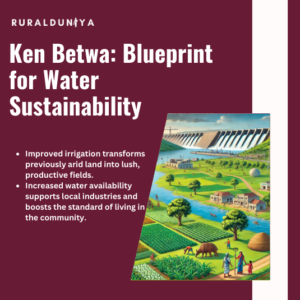The word ‘Viksit Bharat’ denotes a state in which India has achieved a high level of development. Vision 2047 India symbolises the government’s aspiration to elevate the nation into a developed entity by its centenary independence in 2047.
Vision 2047: Insights and Analysis
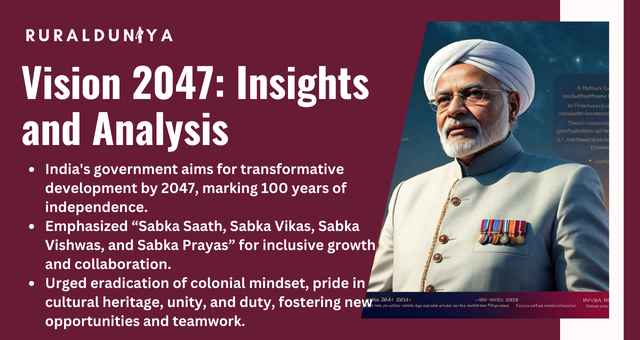
Vision 2047 India is a bold endeavour initiated by the Indian government to establish and accomplish far-reaching objectives for the development of the country by the 100th anniversary of India’s independence in 2047.
In his 2021 Independence Day address, the Honourable Prime Minister outlined his vision for the future, specifically focussing on the period known as Amrit Kaal and the year 2047, which marks the centenary celebration of the country’s independence.
In order to accomplish these objectives, he introduced the motto, “Sabka Saath, Sabka Vikas, Sabka Vishwas, and Sabka Prayas.”
In his 2022 Independence Day address, the Hon’ble Prime Minister highlighted the nationwide celebration of Azadi Ka Amrit Mahotsav and emphasised the importance of embracing the Panch Pran of Amrit Kaal (the five essential elements of a developed India).
These elements include eradicating any remnants of colonial thinking, fostering a sense of pride in our cultural heritage, promoting unity, and instilling a sense of duty among citizens.
He encouraged the populace to cultivate new opportunities, achieve new goals, and progress with certainty. In addition, he emphasised the importance of collaborative endeavours and teamwork in advancing the nation.
Vision 2047 India
The strategic project called Vision India@2047, spearheaded by NITI Aayog, aims to provide guidance for India’s development in the upcoming 25 years.
The project aims to position India as a prominent global leader in the fields of innovation, technology, and sustainability. The primary goals encompass:
- Economic Growth: Attain a USD 30 trillion economy with a per-capita income ranging from USD 18,000-20,000, backed by sound public finances and a resilient banking sector.
- Infrastructure Development: Establish state-of-the-art infrastructure and amenities in both rural and urban regions.
- Governance: Minimise government intervention in the lives of citizens, encourage the development of the digital economy and improve governance practices.
- Industrialisation and Advancement: Facilitate the creation of 3-4 dominant multinational companies in each area through mergers or restructuring, while also promoting the growth of domestic industry and fostering innovation.
- Defence and Space: Attain autonomy in defence and space domains while enhancing India’s worldwide influence.
- Defence and Space: Attain autonomy in defence and space domains while enhancing India’s worldwide influence.
- Environmental Sustainability: Promote ecological balance by enhancing the capability of renewable energy sources and minimising carbon emissions.
- Youth Empowerment: Provide young individuals with the necessary skills and knowledge, while also creating more job prospects.
- Research and Development: Foster partnerships with international R&D organisations to develop cutting-edge laboratories in India and enhance the global ranking of at least 10 Indian universities to be in the top 100 worldwide.
Amrit Kaal Vision 2047
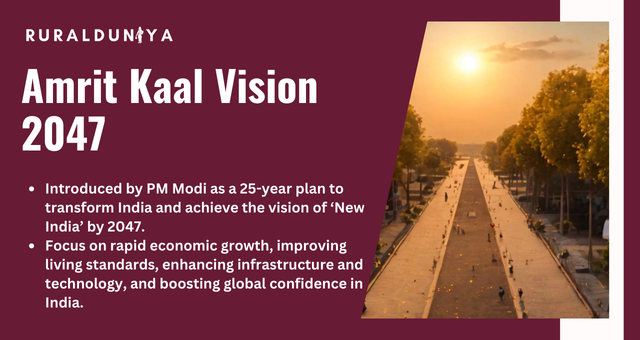
The concept of Amrit Kaal or ‘The Era of Elixir’ was introduced by the Hon’ble Prime Minister Shri Narendra Modi to the entire nation on India’s 75th Independence Day. Amrit Kaal is the Prime Minister’s strategic plan for achieving the vision of ‘New India’ by 2047.
It represents a transformative period for the country, offering the opportunity to satisfy the nation’s aspirations.
He foresaw the next 25 years as a period of restructuring the various components of the Indian economy through quick and lucrative growth, improving living standards for everyone, making gains in infrastructure and technology, and restoring global confidence in India.
The Panch Pran, also known as the 5 principles of Amrit Kaal, encompass the objectives of fostering India’s progress, eradicating remnants of the colonial mentality, cultivating reverence and confidence in our heritage, togetherness, and a feeling of responsibility among citizens.
Vision 2047 Document
The Government is now discussing the development of the Action Plan and goal Document for India@2047, in line with the goal of Hon’ble Prime Minister Shri Narendra Modi to transform India into a developed nation by 2047.
The Indian government is currently in the process of formulating a comprehensive national vision plan with the aim of transforming India into a developed nation by 2047.
The objective is to prevent the country from falling into a middle-income trap, a situation that many countries have experienced during similar stages of growth.
The vision paper will delineate the necessary structural modifications and reforms required to achieve the target.
The report is also anticipated to include information regarding the country’s involvement in international commerce, investment, technology, capital, research, and development organisations.
Vision 2047 MoRTH
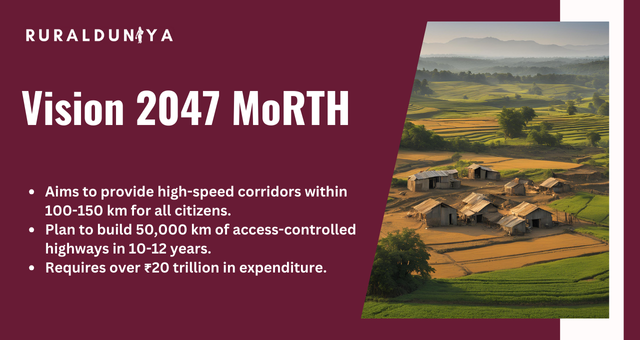
The MoRTH has established a Vision 2047 for the National Highways sector, which acts as the driving principle for the Master Plan of National Highways and related infrastructure.
The paper states that Vision 2047 seeks to ensure that all citizens have access to high-speed corridors within a range of 100 to 150 kilometres.
The Vision 2047 plan will establish new objectives and resume project allocations with the goal of constructing a minimum of 50,000 km of access-controlled highways during the next 10-12 years. This ambitious endeavour would require an expenditure of over ₹20 trillion.
NITI Aayog Vision 2047
The initiative called “Vision India@2047” is a significant endeavour led by NITI Aayog with the objective of formulating India’s development strategy for the upcoming 25 years.
In order to finalise the vision paper, NITI Aayog will seek input from influential individuals such as World Bank President Ajay Banga, Apple CEO Tim Cook, and notable Indian businesspeople and intellectuals.
This consultation aims to improve the goals and fix any potential shortcomings. As the Lok Sabha elections draw near, this initiative could be perceived as a crucial policy commitment by the administration to potential voters.
Viksit Bharat 2047
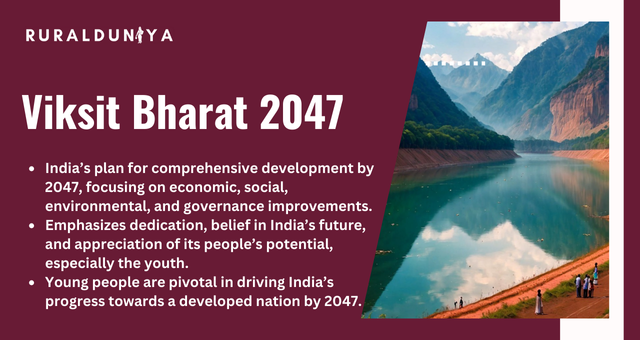
Viksit Bharat@2047 is the Indian government’s ambitious plan to develop the nation by 2047, its centenary. Development includes economic growth, social progress, environmental sustainability, and good governance.
This viewpoint emphasises India’s vital moment. This vision requires unshakeable dedication, a genuine belief in India’s destiny, and a deep appreciation of its people’s talent and potential, especially its youth.
Youth are guiding India towards recessive Bharat by 2047 due of their big population share.
Vision 2047 Logo
The logo is crafted to encapsulate India’s aspiration of emerging as a prominent worldwide influencer, promoting economic advancement, and attaining sustainability by the year 2047.
To obtain the most precise and up-to-date version, it is advisable to refer to official sources such as NITI Aayog or relevant government announcements for the latest design.
Endnote
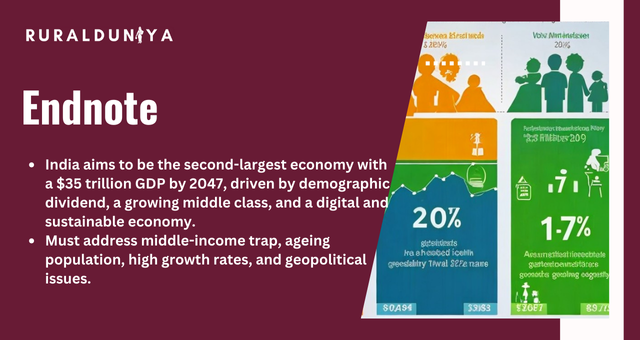
To achieve the Vision 2047 India, the country must be aware of impending obstacles such middle income trap, ageing population, higher growth rate, geopolitical issues, and others.
India is on track to become the second-largest economy by 2047. The Honourable Commerce and Industries Minister predicts India will become a global powerhouse with a $35 trillion GDP by 2047.
Our demographic dividend, growing middle class, digital economy, and sustainability-focused economy will help us achieve our objective for 2047.
To fulfil Viksit Bharat’s 2047 transformational goals, the country must focus on “Sabka Saath, Sabka Vikas, Sabka Vishwas, and Sabka Prayas.”
FAQs
What is special about 2047?
The government’s vision, known as Viksit Bharat 2047, aims to make the country a developed entity by the year 2047, when it celebrates its 100th year of independence.
How should India look in 2047 in different aspects?
In 2047, India’s imports would be valued at USD 12.12 trillion, while its exports are projected to be worth USD 8.67 trillion.
What are the objectives of Vision India 2047?
The goal is to guarantee India’s transition into a developed country by 2047 while avoiding the middle-income trap, which has impacted a number of nations at comparable developmental phases.
What is India target for 2047?
Viksit Bharat @2047 is the vision to make India a developed nation by 2047, the 100th year of independence.

Nishank is a social impact enthusiast with a solid foundation in public policy, micro-enterprise, and agribusiness. Growing up in a farmer’s family has given him a profound connection to rural communities, fueling his passion to empower people towards self-reliance. He completed his undergraduate studies at the Delhi University and earned a master’s degree in Rural Management from National Institute of Rural Development & Panchayati Raj in Hyderabad.


